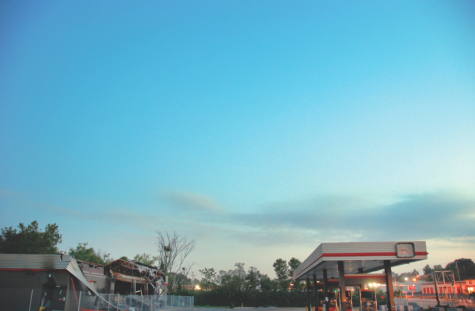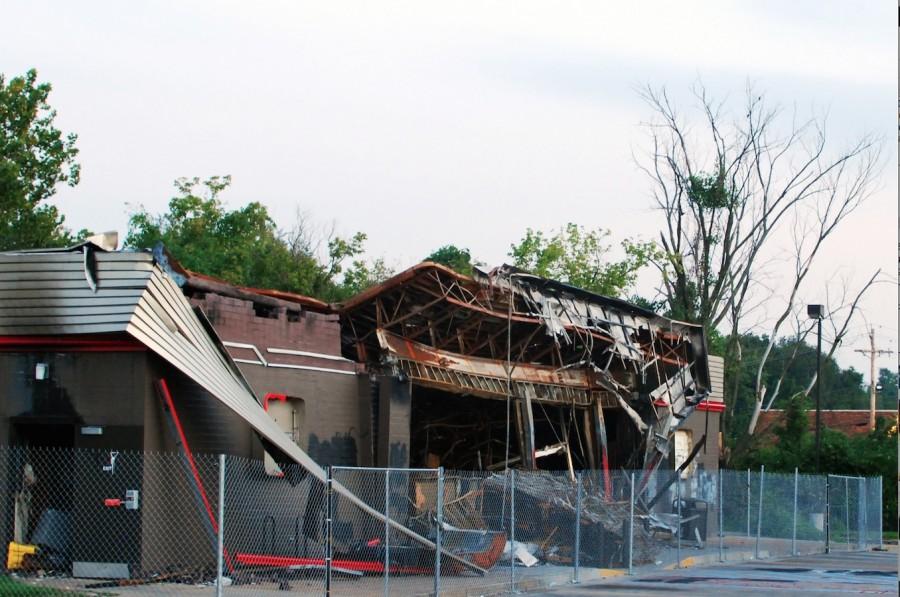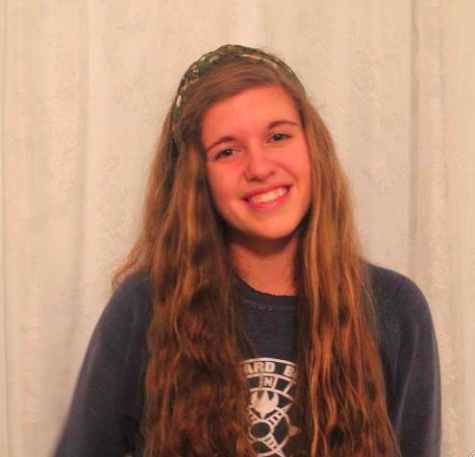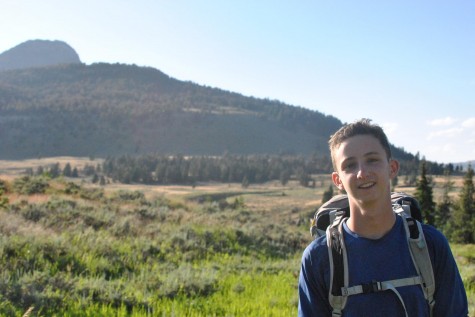Eyes on Ferguson
Remains of the Ferguson QuikTrip that was burned by protestors.
October 9, 2014
I. Introduction
On Aug. 9, 2014, Michael Brown, an African-American 18 year old about to enter college, was shot to death unarmed by a policeman, Darren Wilson, in Ferguson, Missouri, roughly eight miles north of Clayton. In response, a wave of riots and protests swept across Ferguson, St. Louis and America, forcing citizens and the government to begin to address the racial tensions which continue to simmer beneath the nation’s society and culture.
In the weeks since Brown’s death, thousands of news sources and individuals have speculated over the exact circumstances of his death, picking apart unknown questions such as whether or not Brown fought back, which way Brown was facing when he fell and how quickly Wilson discharged his weapons during the altercation.
Ultimately, however, discussions over the facts of the shooting itself are largely futile. The incident went unrecorded and the moments leading up to Brown’s death are spotty and in many places unreliable. Thus, one cannot fully analyze Darren Wilson’s motivations or Mike Brown’s actions without a note of uncertainty and conjecture.
What can be said, however, is that the tensions and conflicts that have been brought to light by the Ferguson shooting and resulting protests represent the culmination of years of geographic, educational and socio-economic segregation within St. Louis and the effect that this segregation has had on its inhabitants and its community.
In this look into the Ferguson crisis, four stories will be told. Each story represents one role experienced during the protests and how each of these roles were impacted by the shooting. They offer unique viewpoints that are essential to consider when forming an opinion and a response to the tragedy. Furthermore, each provides St. Louis residents and citizens of America with powerful lessons in empathy, in bravery and in change.
II. The Resident
“You fear for your life when you see a cop, when they should be here to protect you; you know that they’re not really there for your best interests,” Maalik Shakoor, a 2014 CHS graduate, said.
Shakoor grew up in Baden, Missouri, a district adjacent to Ferguson, and was living there when Brown was shot. Outraged by Brown’s death and exasperated by years of experiencing inequality and racism firsthand, Shakoor, an African-American student at Webster University, quickly joined the rallies and protests filling his neighborhood.
Shakoor participated in a variety of protests, some more successful than others. Immediately after the shooting, much of the community response was fueled by an overwhelming sense of anger and disbelief.
“There is anger because as a black community we are thinking, ‘We’re not valuable. They still think that they can kill us in the middle of the street and people can get away with it,’” Shakoor said.
Although strong feelings of outrage continue to pervade the movement throughout its entirety, as time passed, protesters increasingly began to feel a duty to their growing global voice and presence.
“We felt angry initially, but as the movement started to gain more awareness I felt like we needed to lead by example,” Shakoor recalled. “Right now, all eyes are on Saint Louis. It is kind of a beautiful thing in the wake of a sad moment.”
For Shakoor, this chance at voicing his experiences is long overdue.
Throughout his entire life, Shakoor has had to face daily reminders of America’s racial inequality, from the way people speak to him to the warnings he’s been given by his family.
“If you are young and black, you have this conversation with your parents – I’m pretty sure anyone can attest to this – about how you conduct yourself with the police,” Shakoor said. “For example, the first thing my grandpa told me when I bought my car was not if you get pulled over – not if – but when you get pulled over, Maalik, do not reach for the damn glove box because the cop will think you’re going for a gun.”
For young black people growing up in America, the threat of police aggression is felt – and prepared for – early. From outright warnings like the one Shakoor received to more insidious, inconspicuous messages, many African Americans are taught regularly and repeatedly that policemen pose more of a danger than they do a safety net.
“I know that when I get stopped by a cop, I almost have to prove my innocence to the cop,” Shakoor said.
As the use of police deadly force against unarmed “suspects” become more common (with Michael Brown, Eric Gardner and John Crawford being victims in recent months), many young black men, including Shakoor, are forced to become increasingly alienated from and insecure within the nation’s security system.
When reflecting on Brown’s case specifically, Shakoor was overwhelmed by questions and anger over the injustice of the situation.
“What happened to a fair trial? Why did he come out guns a-blazing? Why did he shoot him from his car, almost like a drive-by? What happened to ‘innocent until proven guilty?'” Shakoor said. “Even if he did steal those cigarellos, I would be disappointed, but that he lost his life for that? No! No. No, because then what? Am I going to get shot?”
The overwhelming sense of suspicion and aggression against young black men goes beyond America’s police forces. Even the way the media deals with shootings like Brown’s reveals underlying double standards within society.
Shakoor recalled one stark comparison that reflected this difference. After the shootings in Aurora, Colorado by James Eagon Holmes and the more recent shootings by Elliot Rodgers, Shakoor felt that many media sources responded overwhelmingly with sympathy and justification while unarmed black victims faced suspicion and accusation.
“Tell me why these guys that shot and killed innocent people in cold blood were portrayed as victims: ‘Oh, they were troubled youths. They were A+ students. But they were just troubled, they were mentally disturbed,’” Shakoor said, “But Mike Brown, a kid shot in cold blood, and Treyvon Martin, a kid shot in cold blood, were painted as thugs… They tried to make us feel like we shouldn’t feel sorry for these kids… They don’t get as much sympathy as a murderer. It’s heartbreaking.”
For Shakoor, escaping this mentality of racism, stereotypes and oppression begins at an individual level. Every American owes one another basic compassion and respect, and education and communication is key in order for this to be possible.
“The main factor in all of this is ignorance. I think someone who’s racist has as much of an effect as someone who refuses to see color, because refusing to see color is basically denying who I am… the [solution] is to understand and listen to each other, and to know that… we’re all human beings,” Shakoor said. “Don’t just try to stereotype me from first sight. Get to know me.”
If Americans are willing to approach Michael Brown’s shooting as an invocation for change and conversation about difficult and complex issues, then some good, Shakoor believes, could emerge from the tragedy.
“I think this will really bring light to true disparity and true struggle of minorities in America. Not just black people, but all who suffer,” Shakoor said.

The burned QuickTrip that was destroyed after Mike Brown’s shooting.
III. The Community Member
CHS French teacher Elizabeth Caspari has attended the St. Stephen’s Episcopal Church in Ferguson for years. St. Stephen’s was responsible for organizing the food drive for Ferguson citizens during the crisis, and she observed first-hand the effect of the tragedy and resulting movement on the community.
Ferguson has a large percentage of low-income families, many of whom rely on food stamps augmented by food banks like Caspari’s church’s in order to survive. When the shooting and subsequent protests and looting broke out, many local grocery stores closed, forcing the St. Stephen’s food bank to shut its doors, or look elsewhere for donations.
“When the news heard that the food pantry was calling for food, there were a lot of people in the area and outside of the area that thought, ‘There’s something we can do to help!’” Caspari said. “In the three weeks since this has hit its peak, we’ve distributed 4500 bags of food.”
Amidst the despair, anger and tragedy of the situation, this outpouring of support from across the nation has offered Caspari and many other community members hope.
“The kind of stuff that was showing up at our church was overwhelming. We have a huge parish hall, and the entire hall was covered with food. The response was really heartwarming,” Caspari said.
It’s moments like this one that remind Caspari of the many aspects of Ferguson that stand out as special and beautiful. Eclipsed behind footage of looting, tear gas and chaos, this was a part of the community that was often forgotten during the weeks following the shooting.
“The news focuses sometimes really heavily on what’s wrong, but there’s a lot right,” Caspari said.
In addition to not writing Ferguson off as a “bad” neighborhood, Caspari also emphasized the importance of not assuming that Ferguson is unique in the issues surrounding race and equality that came to light after the shooting.
“I don’t think we should kid ourselves that this is terribly far away from [Clayton]… I think it could have happened in a lot of places in the St. Louis county and area,” Caspari said.
Nor, Caspari noted, is the sudden attention on St. Louis’s segregation representative of a new awakening among the city.
“This wasn’t a news flash to anybody that spends time [in Ferguson], just like I don’t know very many native St. Louisans who don’t know that we have some racial issues,” she said.
This means that even if Brown’s shooting receives the “justice” demanded by so many protesters, St. Louis will only be treating the symptoms of an illness that is in fact chronic, looming and dangerous.
Rather than an isolated freak accident, Brown’s shooting and the resulting riots represent the tip of an iceberg of tensions that descend deep into St. Louis’s history and politics, reaching from education disparities to economic crises.
“None of this has been fixed,” Caspari said. “It’s not like the concerns have been addressed to their satisfaction. A lot of this has to do with societal inequalities, and you can’t address those overnight.”
IV. The Police Officer
“It’s upsetting. I’m always upset [about the shooting]. Obviously, being a police officer, I always put myself in the position of the police officer. How would I react if I was that officer? … I still think about it now,” CHS Student Resource Officer John Zlatic reflected.
Questions like this one have plagued Zlatic and have been running through the heads of police officers nationwide in the aftermath of Brown’s shooting as a ferocious debate about America’s policing system erupted.
In the light of Brown’s shooting and what appears to be a pattern of police use of deadly force, many Americans are questioning whether or not the current police system has been designed as effectively as possible for the protection of all of its citizens.
One aspect of police work that many citizens might not be aware of is the standard protocol for addressing someone using force.
If a police officer is dispatched to a scene and is attacked, procedure dictates that they must use one level of force greater than that being used against them. So, if a police officer was being attacked with fists, they might use a taser. This plan was designed in order to disarm the attacker and protect all those involved.
“In any given situation [I] have to look at … how can I reasonably take care of this situation or apprehend this person, thinking with regards to the safety of him, myself and everybody else,” Zlatic said.
Often, Zlatic noted, such calls must be made within just a few seconds since altercations quickly escalate, as it seems was the situation with Brown’s death.
When approaching Brown’s case, Zlatic urged onlookers to address the bigger issues surrounding the tragedy rather than to focus on the unknown details of the case.
“I think we need to wait and see how this plays out,” Zlatic said. “And then, after that happens, then I think it’s time to start digesting it … [to look] at this one single event, what started this whole thing, and what were the variables that were problematic with it.”
When thinking about the shooting, Zlatic couldn’t help but imagine himself in Wilson’s position.
“God forbid, if I had to take someone’s life in a situation like that, how do I deal with that? I’m thinking, how many times can you play that through your head and say, ‘Should I have done this, or could I have done that? Could I have changed anything, even if I had done these things, would we have ended up in the same situation?’” Zlatic asked. “I think you’re always going to think about that, and it’s a hard situation to be in.”
V. The Educator
“I take my role of teacher pretty seriously, so I’m always trying to talk to the people in my various communities and help provide the frameworks for rethinking some of these problems,” Dr. Jonathon Smith, a professor at Saint Louis University, said.
Smith has worked with CHS through several mediums in the past to educate and discuss issues of race and equality in Clayton and St. Louis
Since Brown’s shooting, Smith attended rallies at Ferguson and has worked to promote and lead discussions on improving and addressing race relations within St. Louis. Recently, he collaborated with CHS’s Drama Department to stage and discuss a professional reading of “The Dutchman” for CHS students and faculty in order to foster conversation about the crisis.
A longtime resident of St. Louis, Smith saw the riots as emblematic of an insidious and ancient problem in the city and nation that has affected his community, his students and himself.
“It just felt like I couldn’t not go [to the protests]. I couldn’t ignore this thing that’s really a backyard issue, not just as someone gaping at a traffic accident, but as someone who could feel potentially affected by incidents like this,” Smith said.
For Smith, an African American man, issues of race and police bias have plagued him for most of his life and have become the study of much of his work. Stereotypes and oppression still exist in much of American society and consciousness, Smith believes, and many young black men face difficult challenges and expectations because of that.
Smith also noted a dangerous pattern in the media response to Brown’s shooting and what it means in the discussion over police deadly force. Immediately after his death, an outpouring of news sources began a fierce debate over Brown’s moral character, deriving judgements from rumors of his actions and statements leading up to his death. Many have accused the media of attempting to paint Brown as a thug and a criminal in order to discourage support for him.
“There’s a kind of cultural response that seems to suggest that if this wasn’t a perfect kid, then what’s the big deal? And that’s a very dangerous approach to take to the use of deadly force by police in the street, because the moral quality of a citizen shouldn’t matter in terms of assessing whether that citizen should be met by deadly force,” Smith said.
The same applies to speculation over whether or not Brown had stolen $50 worth of cigarillos from a nearby liquor store immediately before his death and the role that might have played in the shooting and its possible justification. The supposed morality – or even legality – of Brown’s actions before his death play no role in the debate over his murder, Smith argues.
“Police are enforcement officers, not judge and jury,” he said.
According to Smith, when people attempt to paint Brown in moral extremes – angel or devil, good or evil – they allow a dangerous tradition to enter the conversation surrounding America’s police system: judging people’s morality as an indicator of whether or not they “deserve” to die.
“You get some people who want to turn Mike Brown into a saint and then people on the other side who want to turn him into the devil. When that happens, you lose this other conversation in the middle, because both of those end up giving disproportionate weight to ‘good guy/bad guy.’ They’re saying, ‘He’s a good guy, he shouldn’t have been shot!’ or ‘He’s a bad guy, he shouldn’t have been shot!’ Then you lose the part in the middle: ‘He’s a guy, he should not have been shot,’” Smith said.
Discussions like this one over police deadly force and America’s legal system are just one facet of the hundreds of issues that have been brought to light by Brown’s shootings and the Ferguson protests, especially in St. Louis.
Ultimately, the system of prejudice and aggression that resulted in Brown’s shooting is far from new to the St. Louis area. Smith argues that much of this structure and the hostile and oppressive environment it creates within St. Louis will persist unless citizens rethink their daily actions and perceptions.
“Conversations about the relationships between the city and the county are old, old, old conversations, and as long as no one really does the work of rethinking these big concepts and learns how to frame them and how to see other people differently across the table, we’re going to end up repeating the same thing,” Smith said.
Despite the revolutionary nature of the protests, for Smith, little has changed in his view of himself or his understanding of the stereotypes and aggression he and thousands of other black men face every day.
“In many ways, this whole thing hasn’t taught me anything new about the world. It certainly didn’t teach me anything new about myself and the body I live in. It’s simply reinforced stuff I already knew,” he said.
If events like Brown’s shooting continue to occur unhindered, Smith warned that America’s systems of inequality will continue to consume the lives of thousands of young men, just as it’s already touched Shakoor’s.
Despite this looming shadow, Smith witnessed key moments of hope and transcendence within the crushing tragedy of the protests.
“There’s something very affirming about seeing nationally known figures, political and otherwise, embedded in a crowd of ordinary people from all over St. Louis. It wasn’t just African Americans – it was a widely diverse group,” Smith said. “It indicates the possibility that whatever the situation, there are moments where all of us can drop the things that normally separate us and find some way to actually get together harmoniously.”
VI. Conclusion
The shooting of Michael Brown and the protests that inundated Ferguson afterwards have irreparably altered the lives of thousands of people across St. Louis and the nation. Brown’s family lost a cherished boy on the cusp of his adult life. The Ferguson community was rattled by daily protests that shook its streets and brought tear gas and snipers into its front yards. Police officers across the nation have met huge criticism and growing chastisement, and tactics have come under question and attack in many areas.
Brown’s shooting and the Ferguson protests are, above all else, complex. They can’t be summarized in a five minute sound byte or a speech tacked on to the end of the daily news. Instead, the Ferguson crisis is one made up of hundreds of individual stories just like the ones told here, and in order to understand the tragedy one must work to comprehend and empathize with the human beings themselves who have lived it in a variety of unique ways.
From residents to community members, police officers to educators, everyone has a story to tell and a perspective to offer. If any good can be said to have come from Brown’s untimely death, it is perhaps the fact that these voices are finally being heard within the Ferguson community and beyond, and messages of revival and transformation are coming with them.
In the days following Brown’s death, protestors burned a QuikTrip located near the shooting to the ground. Soon after, a chain link fence was erected around the perimeter of the property.
Community members and mourners flooded the area, standing as close as they could to the place where the movement which had enveloped and changed many of their lives first began.
They covered the fence in messages carefully drawn onto brightly colored ribbons: letters to the boy with whom they would never again be able to speak, encouragement to their neighbors, prayers for a better future.
One such ribbon stands out from the multitude.
It reads, “Hope and pray that all will see the very good that is Ferguson, my home town for almost 60 years. Unity, acceptance, caring, improvement, growth, hope, forgiveness, love!”



